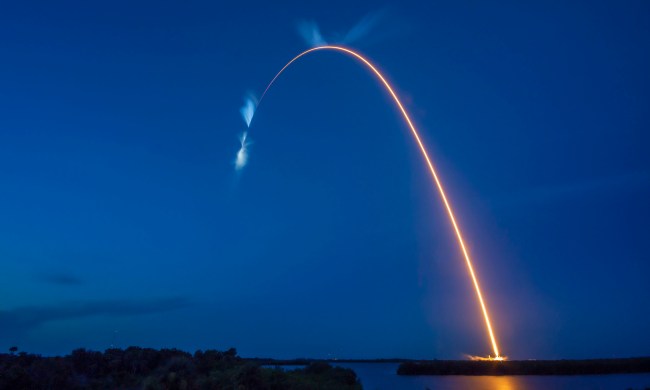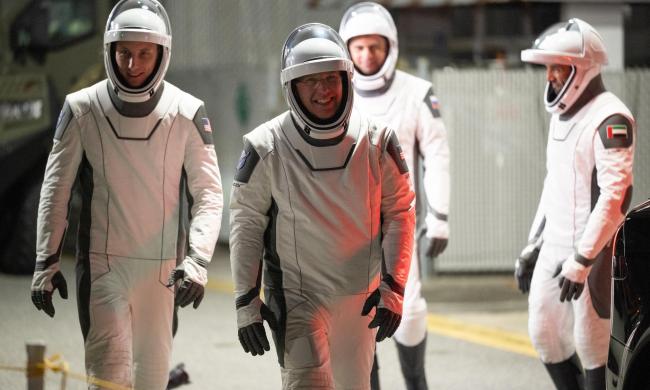
Georgina Torbet
Space Writer
Georgina is the Digital Trends space writer, covering human space exploration, planetary science, and cosmology. She specializes in current and future exploration of Mars. She has previously written about science, technology, and security topics for websites like SlashGear, Engadget, and Futurism. She has a master's degree in neuroscience and a PhD in psychology.

How to watch the SpaceX resupply launch to the ISS this week
How to watch the SpaceX resupply launch to the ISS this week
This week, a SpaceX Cargo Dragon will blast off from Florida carrying scientific equipment and supplies to the International Space Station. Here's how to watch.

Astronomers share early images from James Webb’s galaxy survey
Astronomers share early images from James Webb’s galaxy survey
The snapshot of the sky captured by James Webb shows 25,000 galaxies -- and it's just a taste of what is to come.

Water was present in our solar system before the sun formed
Water was present in our solar system before the sun formed
Astronomers are looking to a distant star system still in the planet-forming phase to understand how water came to be on Earth.

Four Crew-5 astronauts return home safe from International Space Station
Four Crew-5 astronauts return home safe from International Space Station
A crew of four astronauts has returned safely to Earth from the International Space Station, splashing down in the Gulf of Mexico off the coast of Florida.

Hubble captures a messy irregular galaxy which hosted a supernova
Hubble captures a messy irregular galaxy which hosted a supernova
This week's image from the Hubble Space Telescope shows a spiral galaxy called NGC 5486, shot through with wisps of pink where new stars are being born.

How James Webb is peering into galaxies to see stars being born
How James Webb is peering into galaxies to see stars being born
Researchers are using the James Webb Space Telescope to study galaxies similar to our Milky Way to understand how they grow and evolve.

See the Ingenuity helicopter’s stunning image of a Martian sunset
See the Ingenuity helicopter’s stunning image of a Martian sunset
The tiny helicopter Ingenuity is still continuing to explore Mars, gearing up for its 47th flight. Recently it snapped an image of an otherworldly sunset.

How to watch the Crew-5 mission splash down tonight
How to watch the Crew-5 mission splash down tonight
A crew of four astronauts has left the International Space Station and is due to splashdown into the ocean later tonight. Here's how to watch.

Hubble captures a cosmic sea monster with this image of a jellyfish galaxy
Hubble captures a cosmic sea monster with this image of a jellyfish galaxy
This Hubble image shows a jellyfish galaxy, a galaxy type named for its larger main body with tendrils that float along after it like the sea creature.

Researchers design a ‘space salad’ to keep astronauts healthy and happy
Researchers design a ‘space salad’ to keep astronauts healthy and happy
Researchers have come up with an astronaut salad, that meets the nutritional needs of astronauts and features foods that could be grown in space.

Roman Space Telescope will survey the sky 1,000 times faster than Hubble
Roman Space Telescope will survey the sky 1,000 times faster than Hubble
The Nancy Grace Roman Space Telescope, set to launch in 2027, will look at vast areas of space to help cosmologists understand the universe on a large scale.

Faulty nozzle caused the loss of European Vega-C rocket last year
Faulty nozzle caused the loss of European Vega-C rocket last year
Last year, Europe's Vega-C rocket failed on its second mission. Now, a commission had found that the problem was due to a faulty engine part.

James Webb captures an extremely distant triple-lensed supernova
James Webb captures an extremely distant triple-lensed supernova
Webb imaged a huge galaxy cluster located 3.2 billion light-years away, which is acting like a magnifying glass and showing a far-off supernova in triplicate.

Satellites like SpaceX’s Starlink are disrupting Hubble observations
Satellites like SpaceX’s Starlink are disrupting Hubble observations
Only a few Hubble observations are affected for now, but the problem is going to get much, much worse.

Rovers could explore lava tubes on Mars or the moon using breadcrumbs
Rovers could explore lava tubes on Mars or the moon using breadcrumbs
Engineers propose using robots to scout out lava tubes for use as human habitats with a method inspired by Hansel and Gretel.

Telescope captures the remnants of a supernova first seen 2,000 years ago
Telescope captures the remnants of a supernova first seen 2,000 years ago
Astronomers recently captured a remnant called RCW 86, which is the result of a supernova which was observed by Chinese astronomers in the year 185 C.E.

Hubble sees the dramatic collision of NASA’s DART spacecraft and an asteroid
Hubble sees the dramatic collision of NASA’s DART spacecraft and an asteroid
NASA says the test has shown it is possible to deflect an asteroid if one were threatening Earth -- but only if it is spotted in time.

Scientists find a solid metallic ball within the Earth’s core
Scientists find a solid metallic ball within the Earth’s core
The innermost inner core of the planet is thought to be a solid metallic ball around 400 miles across, according to seismologists.

NASA and SpaceX Crew-6 mission ready for launch tonight
NASA and SpaceX Crew-6 mission ready for launch tonight
NASA is ready to launch four astronauts to the International Space Station, with preparations underway and launch scheduled for late tonight.

An enormous galaxy cluster warps spacetime in this Hubble image
An enormous galaxy cluster warps spacetime in this Hubble image
Much of the universe is too far away for even powerful telescopes to observe -- so researchers make use of a natural occurrence called gravitational lensing.

New Russian Soyuz craft arrives at space station to replace leaky one
New Russian Soyuz craft arrives at space station to replace leaky one
A Russian Soyuz spacecraft has docked at the International Space Station, ready to carry astronauts as a replacement for another Soyuz that leaked last year.

The science experiments that the Crew-6 astronauts will be performing on the ISS
The science experiments that the Crew-6 astronauts will be performing on the ISS
Four astronauts will soon launch to the ISS where they'll perform scientific research, working on a wide variety of experiments.

James Webb spots ‘universe-breaking’ massive early galaxies
James Webb spots ‘universe-breaking’ massive early galaxies
The James Webb Space Telescope continues to throw up surprises, and recently it has been used to spot some very old galaxies which have astonished astronomers.

Weirdly large ‘forbidden’ exoplanet orbits a relatively tiny star
Weirdly large ‘forbidden’ exoplanet orbits a relatively tiny star
Astronomers have discovered a forbidden planet that appears to be far larger than should be possible given its circumstances.

Astronomers create epic map of more than 1 billion galaxies
Astronomers create epic map of more than 1 billion galaxies
A data release from the Dark Energy Spectroscopic Instrument (DESI) Legacy Imaging Survey shared the results from six years of scanning almost half of the sky.

Venus’ volcanic activity has left it with a squishy outer shell
Venus’ volcanic activity has left it with a squishy outer shell
Researchers have dug through data from a decades-old NASA mission to learn about the strange geological processes which renew Venus' surface.

How to watch the SpaceX Crew-6 mission launch this week
How to watch the SpaceX Crew-6 mission launch this week
A crew of four astronauts is about to launch for the International Space Station. Here's how to watch the early stages of the mission live.

Webb uses a galactic megacluster as an enormous magnifying lens
Webb uses a galactic megacluster as an enormous magnifying lens
To look at some of the most distant galaxies, astronomers take advantage of a phenomenon called gravitational lensing.

Russian replacement Soyuz scheduled for February 24 launch
Russian replacement Soyuz scheduled for February 24 launch
Russia's space agency has announced it plans to launch a replacement Soyuz to bring home ISS crew members later this month.

Three galaxies are in the process of merging in this Hubble image
Three galaxies are in the process of merging in this Hubble image
This week's image from the Hubble Space Telescope shows a dramatic collision of three different galaxies.

NASA and Boeing set date for first crewed test flight of Starliner
NASA and Boeing set date for first crewed test flight of Starliner
The launch of the first crewed flight of the Boeing Starliner is scheduled for April this year.

James Webb captures swirls of dust and gas in nearby galaxies
James Webb captures swirls of dust and gas in nearby galaxies
The James Webb Space Telescope is helping astronomers to peer into nearby galaxies and see elaborate structures of dust and gas.

Look at this weird-shaped asteroid NASA just spotted
Look at this weird-shaped asteroid NASA just spotted
NASA recently observed an asteroid that is roughly the same dimensions as the Empire State Building.

Aurorae light up the skies over Jupiter’s four largest moons
Aurorae light up the skies over Jupiter’s four largest moons
One of the great natural wonders of the world are the Northern Lights, but aurorae aren't just limited to Earth -- they are on other planets and moons as well.